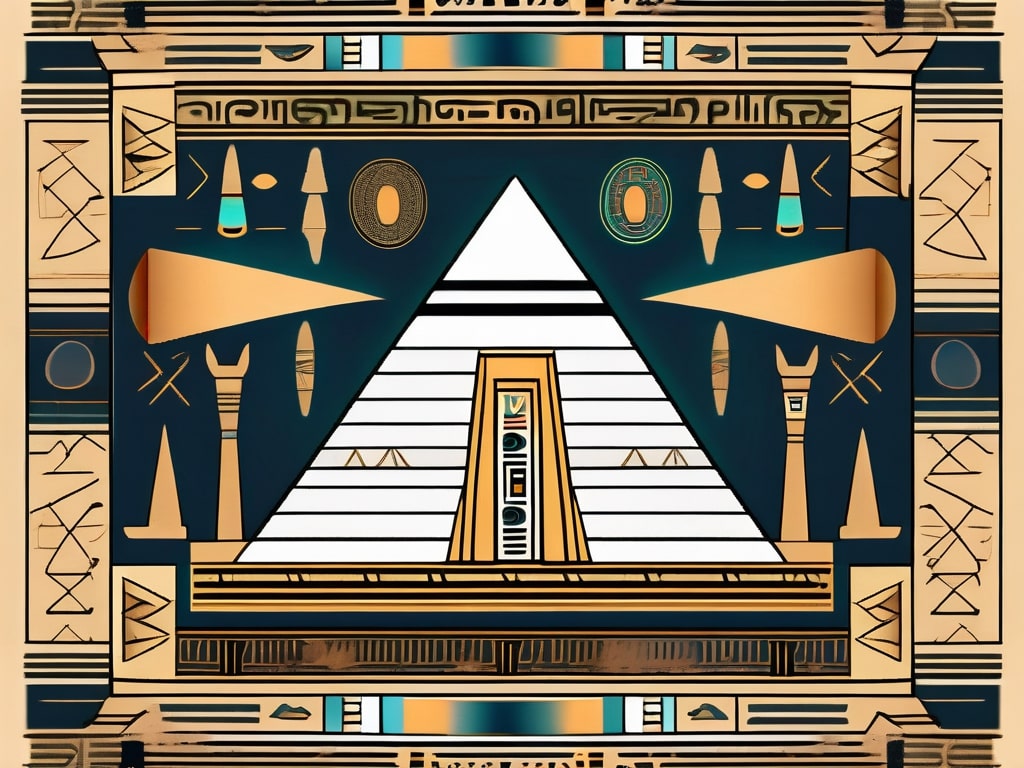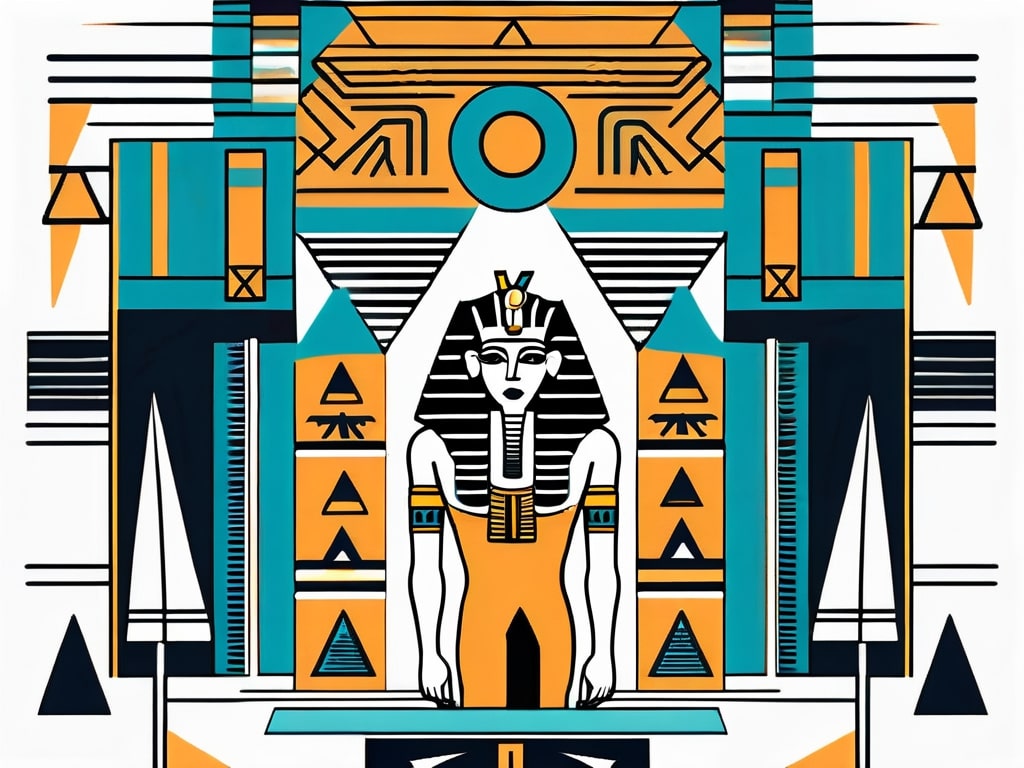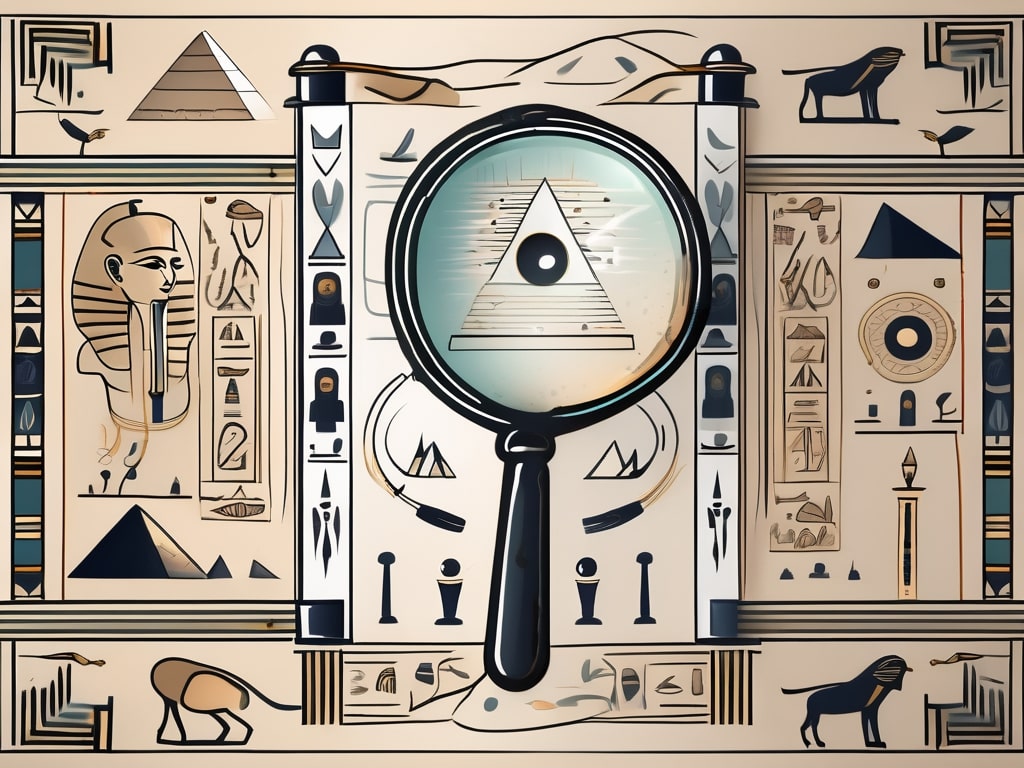Reading Egyptian symbols can be a fascinating and rewarding endeavor. Whether you are interested in ancient history and mythology or simply have a curiosity for deciphering ancient scripts, understanding the basics of Egyptian symbols is essential. In this article, we will explore the importance of Egyptian symbols in history, the structure of Egyptian hieroglyphs, the process of translating them, the challenges in reading them, and their role in modern culture.
Understanding the Basics of Egyptian Symbols
Egyptian symbols have played a significant role in shaping our understanding of ancient civilizations. They were not only a form of written communication but also a means to represent their culture and beliefs. By studying these symbols, we gain insights into the daily lives, religious practices, and historical events of the ancient Egyptians.
Ancient Egyptian symbols were not just random drawings but held deep meanings and significance. For example, the Ankh symbol, resembling a cross with a loop at the top, represents life and immortality. The Eye of Horus symbol was associated with protection, royal power, and good health. Each symbol was carefully crafted and imbued with layers of cultural and religious symbolism.
The Importance of Egyptian Symbols in History
The Egyptians used symbols extensively to record their history. From monumental inscriptions on temples to smaller inscriptions on papyrus scrolls, these symbols provide crucial information about pharaohs, battles, and dynastic successions. They also served to preserve their cultural heritage for future generations.
Deciphering Egyptian symbols requires a deep understanding of their context and cultural significance. For instance, the Scarab beetle symbolized rebirth and regeneration due to its association with the sun god Ra. Understanding these intricate connections between symbols and beliefs offers a glimpse into the spiritual and philosophical aspects of ancient Egyptian society.
The Structure of Egyptian Hieroglyphs
Egyptian hieroglyphs are pictorial representations of objects or concepts. They include various elements such as ideograms, phonograms, and determinatives. Ideograms represent ideas or concepts, while phonograms are symbols that represent sounds. Determinatives are non-phonetic symbols that assist in clarifying the meaning of a word.
These elements combined in a hieroglyphic script create a complex system of symbols that can be challenging to decipher. However, with patience and the right tools, the process becomes an engaging and enlightening adventure.
Deciphering Common Egyptian Symbols
When delving into the world of Egyptian symbols, it is essential to familiarize yourself with common symbols and their meanings. Egyptian gods and goddesses were often depicted with specific symbols representing their attributes or domains.
Exploring the intricate world of Egyptian symbols unveils a rich tapestry of meanings and cultural significance. Each symbol is a window into the beliefs and practices of ancient Egyptians, offering a glimpse into their complex and fascinating civilization.
Symbols of Egyptian Gods and Goddesses
The gods and goddesses of ancient Egypt significantly influenced the daily lives of its people. Symbols such as the ankh, representing life, or the winged sun disk, associated with the god Ra, were commonly used in religious ceremonies and temple decorations.
These symbols were not merely decorative but held deep spiritual meanings, guiding the Egyptians in their worship and daily rituals. The ankh, for example, symbolized eternal life and was often carried by gods and pharaohs alike as a powerful emblem of protection and divine favor.
Symbols Representing Daily Life in Ancient Egypt
Egyptian hieroglyphs depict scenes from daily life in addition to religious symbols. Symbols representing activities such as agriculture, pottery making, and fishing provide valuable insights into the daily routines and occupations of ancient Egyptians.
These depictions offer a glimpse into the economic and social structures of ancient Egyptian society, showcasing the importance of agriculture, craftsmanship, and trade in sustaining their civilization. Each symbol tells a story of labor, innovation, and community cooperation, painting a vivid picture of daily life along the banks of the Nile.
The Process of Translating Egyptian Hieroglyphs
Translating Egyptian hieroglyphs is a fascinating journey into the ancient world, requiring a unique combination of knowledge, tools, and methodology. The intricate symbols and pictograms used in hieroglyphs offer a glimpse into the rich history and culture of ancient Egypt, making the deciphering process both challenging and rewarding.
One of the key aspects of translating hieroglyphs is understanding the symbolic nature of the script. Each hieroglyph carries not only a phonetic value but also a deeper meaning or representation, adding layers of complexity to the translation process. By delving into the symbolism behind the hieroglyphs, translators can uncover hidden messages and insights left behind by the ancient Egyptians.
Tools Needed for Translating Hieroglyphs
One essential tool for translating hieroglyphs is an Egyptian hieroglyphic dictionary. These dictionaries serve as invaluable resources, providing researchers with the phonetic values of the hieroglyphs and aiding in the matching of symbols to corresponding sounds. In addition to dictionaries, specialized software and online resources have become indispensable in the field of Egyptology, offering advanced tools for translation, analysis, and research.
Another crucial tool for deciphering hieroglyphs is a comprehensive understanding of ancient Egyptian culture, history, and language. By immersing oneself in the world of ancient Egypt, researchers can gain a deeper appreciation for the context in which the hieroglyphs were created, leading to more accurate translations and interpretations.
Steps to Decoding Egyptian Symbols
Decoding Egyptian symbols requires a systematic approach that combines linguistic analysis with historical context. Beginning with the identification of common symbols, researchers can then progress to transliteration and transcription, unraveling the phonetic values of the hieroglyphs. As translators develop a familiarity with the symbols and their sounds, they can delve into the intricate grammar and syntax of the inscriptions, piecing together the meaning of the text.
Furthermore, the process of translating Egyptian hieroglyphs often involves collaboration among experts in various fields, including linguistics, archaeology, and history. By pooling their knowledge and expertise, researchers can tackle the challenges posed by complex inscriptions and ambiguous symbols, working together to unlock the secrets of the ancient Egyptian civilization.
Challenges in Reading Egyptian Symbols
Reading Egyptian symbols is not without its challenges. Incomplete or damaged hieroglyphs can hinder the translation process. However, with perseverance and knowledge of contextual clues, these obstacles can be overcome.

One of the key challenges faced by researchers is the deciphering of symbols that have been eroded or damaged over time. The wear and tear on ancient artifacts can sometimes obscure crucial details, making it difficult to accurately interpret the intended meaning. In such instances, experts employ advanced imaging techniques, such as reflectance transformation imaging (RTI) or multispectral imaging, to enhance the visibility of faded symbols and facilitate a more precise analysis.
Dealing with Damaged or Incomplete Hieroglyphs
Damaged or incomplete hieroglyphs pose a unique challenge. In such cases, researchers rely on a combination of known symbols, context, and similar inscriptions to fill in the gaps. Comparisons with related texts and parallel inscriptions can offer valuable insights into the missing portions.
Furthermore, the study of paleography, which involves analyzing the style and script of ancient writing, plays a crucial role in deciphering damaged hieroglyphs. By examining the stroke patterns, artistic conventions, and evolution of writing styles over different time periods, scholars can make educated guesses about the missing elements in a text and reconstruct the original message with greater accuracy.
Understanding the Context of Symbols
Context is crucial when deciphering Egyptian symbols. The meaning of a symbol may vary depending on the surrounding symbols and text. By studying the broader context of an inscription, researchers can gain a deeper understanding of the intended message.
Moreover, the cultural and historical context in which the symbols were created is essential for interpreting their significance. Factors such as religious beliefs, political events, and social customs prevalent during the time of inscription can greatly influence the meaning of symbols. By delving into the rich tapestry of ancient Egyptian society, researchers can unravel the layers of symbolism embedded in hieroglyphic texts and unveil the secrets of the past.
The Role of Egyptian Symbols in Modern Culture
Even in modern times, Egyptian symbols continue to captivate and inspire. Their iconic imagery can be found in various forms of art, design, literature, and film.

Exploring the intricate world of Egyptian symbols reveals a deep connection to the ancient civilization’s beliefs, rituals, and daily life. Each symbol carries layers of meaning, from protection and guidance to fertility and rebirth, providing a glimpse into the complex tapestry of Egyptian culture.
Egyptian Symbols in Art and Design
The artistic legacy of ancient Egypt can be seen in paintings, sculptures, jewelry, and architectural designs. Elements such as the Eye of Horus or scarab beetles are frequently incorporated into contemporary artworks, adding a touch of ancient mystique.
Artists and designers draw inspiration from the rich visual language of Egyptian symbols, infusing their creations with a sense of timelessness and mystery. The enduring appeal of these symbols lies in their ability to transcend centuries, resonating with modern audiences seeking to connect with the past.
Egyptian Symbols in Literature and Film
Ancient Egyptian symbols have also found their way into literature and film. From fantasy novels to blockbuster movies, the allure of Egyptian mythology and symbolism continues to capture the imagination of audiences worldwide.
Authors and filmmakers often weave Egyptian symbols into their narratives, using them to add depth and intrigue to their stories. Whether as mystical artifacts, powerful talismans, or enigmatic prophecies, these symbols serve as a bridge between the ancient world and contemporary storytelling, inviting audiences to embark on a journey through time and imagination.
As we conclude our exploration of how to read Egyptian symbols, we hope you have gained a deeper appreciation for the significance and beauty of this ancient script. Whether for academic study or pure curiosity, the journey of deciphering Egyptian symbols is an enriching experience that allows us to connect with the rich history of one of the world’s most fascinating civilizations.

